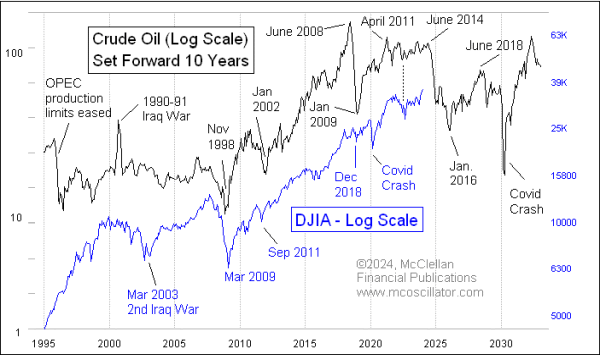This post was originally published on this site
https://images.mktw.net/im-15378772U.S. stocks and oil can sometimes move together, but a period of decline for oil ten years ago indicates potential for a steep stock market decline that may begin this summer, according to Tom McClellan, editor of The McClellan Market Report.
In what he referred to as a “fun leading indication relationship,” McClellan wrote in a Thursday note that the movements of crude-oil prices
CL.1,
CLJ24,
“tend to show up again as stock price movements about 10 years later.”
He admits that he doesn’t have a good explanation as to why this relationship works, but believes it has been working for the most part ever since the Dow Jones Industrial Average
DJIA
was first created back in 1896. “At some point, when there is this much evidence, one can let go of the quest for the ‘why’, and accept the ‘is’,” said McClellan.

Crude-oil price movements have shown up as stock price movements 10-years later, says Tom McClellan, editor of The McClellan Market Report.
McClellan Financial Publications
The chart from McClellan shows a sharp fall in oil prices between June 2014 and January 2016.
The boom in U.S. fracking was underway in 2014, boosting oil production, and to keep prices up in the face of that new supply, the Organization of the Petroleum Exporting Countries was trying to cut output, then gave up that fight in the summer of 2014, said McClellan. Oil prices then dropped through January 2016.
If the 10-year lag-time relationship between oil and stock market continues to work, “as it has worked for more than a century,” that would mean a big decline for the stock market between June 2024 and January 2026 — the magnitude of which is unknown, he said.
Stock prices in 2018 echoed the big oil-price crash 10 years earlier, that was part of the collapse of the generalized commodities bubble in 2008, but it was a much more quiet down move in stocks during 2018, said McClellan.
The big bear market of 1929 to 1932, meanwhile, unfolded “on schedule,” and echoed the collapse of the Texas oil boom which started to unfold in 1920, but the stock market fell much harder than oil had suggested, he said.
So if anyone is going to employ this “fun leading indication relationship” between oil and the stock market, they’ll need to keep a few things in mind, said McClellan.
The 10-year lag is not always precisely 10.0 years, he said. “Sometimes the stock market’s actual turns vary from that ideal lag time by a few months.”
The magnitudes of crude oil’s movements, meanwhile, do not necessarily get echoed by the stock market, said McClellan. “This model is more about the timing of the turns than the severity of them.”
Also, on occasion, an “exogenous event can come along and disrupt things,” he said.
The March 2020 “Covid Crash” is not something which crude oil appears to have known was coming but after that event, the major stock market averages “worked extra hard to get back on track,” he said. And in 1990 to 1991, when oil prices briefly doubled after Iraq attacked Kuwait, then collapsed back down again to their prior price levels, stocks did not echo that “anomalous spike.”
Even so, based on the leading indication model, McClellan said he’s confident in his expectations that the period between June 2024 and January 2026 is “not going to be a great time for the stock market, and also not great for whoever wins the November 2024 elections.”
On that same basis, he said he looks forward to the “big bull market which this model says is coming between 2026 and 2028.”
So far this year, U.S. benchmark West Texas Intermediate crude have stuck to a tight trading range, with a less than $10-per-barrel difference between the highs and lows in prices, which could make for a quieter trading period for the domestic stock market roughly 10 years from now.

